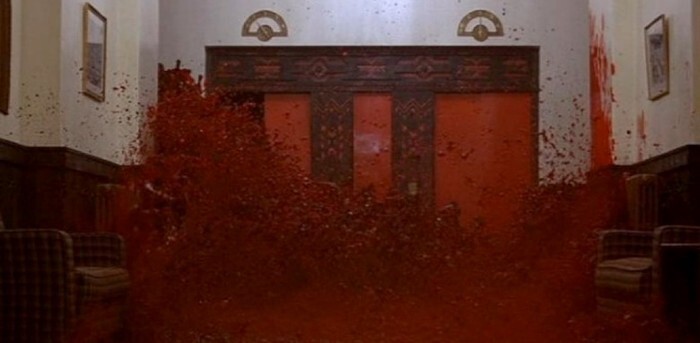15 Hilarious Ways Movies and TV Shows Got Past the Censors

(Paramount Pictures)
It’s kind of the nature of artistic expression to push the boundaries of polite society, so naturally, artists and arbiters butt heads over exactly how much boob they can show. Artists tend to win out due to all that inherent creativity, sometimes sneaking past the censors so hilariously that they surely can’t even be mad.
Star Trek

(CBS Paramount Television)
A 1968 episode of Star Trek was written to feature a kiss between actors William Shatner and Nichelle Nichols, one of the first interracial kisses on TV, but the nervous network asked them to do a take where they just faked the kiss in case they changed their minds. During the take with the fake kiss, however, the director got distracted by some alien cleavage or something, so Shatner looked directly at the camera and crossed his eyes, ensuring the take couldn’t be used.
Watchmen

(Warner Bros.)
The MPAA forbid Zack Snyder from including “like 12 frames,” according to Snyder, of a gun being pointed at the camera in a trailer for Watchmen, so he went Spielberg on them and replaced it with a walkie talkie. The trailer then cuts to a real gun, so to all but the most nitpicky viewers, it looks like a gun the whole time. It seems like he could have just cut half a second of footage, but where’s the fun in that?
Happy Days

(ABC)
During the first season of Happy Days, the Fonz had to wear nerdy little windbreakers because the network thought his leather jacket made him look like a criminal, so creator Garry Marshall pointed out to them that it was unsafe to ride a motorcycle without one. They agreed to let the character wear a leather jacket only in scenes with his motorcycle, lest some young viewer leave a trail of skin and nylon down their local highway, so Marshall made sure to put his motorcycle in every single Fonzie scene until the character became so popular that the network couldn’t have cared less how many kids he turned into criminals.
Fight Club

(20th Century Fox)
In Fight Club’s original script, the line Marla said after having sex with Tyler Durden was “I want to have your abortion,” which producer Laura Ziskin insisted David Fincher replace. He agreed, but only on the condition that she couldn’t change whatever he came up with. “Go ahead,” she said. “Nothing could be worse.” He proved her wrong, changing the line to “I haven’t been fucked like that since grade school,” and she begged him to change it back, but they had a deal, and apparently Hollywood runs on playground rules.
The Ren & Stimpy Show
Looking back with tainted adult eyes, it’s a wonder that anyone, let alone children, was allowed to watch Ren & Stimpy, but according to writer Bob Camp, “the censors were just clueless.” All they knew was that they always had to cut something, so “we would throw red herrings in just so that they would have something to cut out … in hopes that they would leave other jokes that we really needed in there.”
This is the End
Seth Rogen and Evan Goldberg took a similar approach to This is the End, flooding it with so much gratuitous profanity and giant swinging devil dicks that they assumed the MPAA would send it back automatically, and once they cut all that stuff out, the version they actually wanted would seem tame by comparison. In fact, Sony explicitly advised them to do that. To everyone’s surprise, the ratings board was fine with their first cut, satanic hog and all.
South Park: Bigger, Longer, & Uncut

(Paramount Pictures)
Matt Stone and Trey Parker, meanwhile, got so frustrated with the MPAA during production of the 1999 South Park movie that “every time they made us cut something, we put in something worse as a big middle finger to them.” They weren’t even trying to be sneaky, they were just doing what they do best and being obnoxious for the sake of it, but they were continually amazed to find that the ratings board approved what they thought were much sicker jokes, like Mrs. Cartman getting shit on instead of boning a horse in the porn the boys find.
Goldfinger

(United Artists)
Essentially naming a character “Vagina Everywhere” would be risky even today, so in 1964, the publicity team behind Goldfinger had to pull a stunt that went all the way up to the British monarchy. They connived to have their star photographed with Prince Philip at a party, then gave newspapers exclusive rights to the photo as long as they published it under the headline “The Prince and the Pussy.” The producers then showed the papers to the American censors, who were convinced that the Prince couldn’t be involved with anything less than upstanding because they hadn’t seen The Crown yet.
The Maltese Falcon
In the book The Maltese Falcon was based on, some of the characters after the coveted bird are explicitly gay, but the 1941 movie couldn’t portray them as such, so they referred to them using gay slang that the censors weren’t cool enough to know. In fact, so many people misinterpreted one of the terms -- “gunsel,” meaning the young “kept” man of an older man -- that it became synonymous with “gunman.”
The Shining

(Warner Bros.)
The trailer for The Shining, which is basically just 30 seconds of elevator blood, is iconic now, but it was recalled by the MPAA, who were told the red liquid was just “rusty water,” after it proved extremely obvious to everyone else that it was blood.
Notorious

(RKO Radio Pictures)
When Alfred Hitchcock made Notorious in 1946, the Hays Code prohibited kisses longer than three seconds, which was a problem because the movie featured a lengthy makeout session between Cary Grant and Ingrid Bergman. It turns out all he had to do was tell the actors to break apart every three seconds to convince the censors that it was actually several short kisses.
Psycho

(Paramount Pictures)
A decade and a half later, Hitchcock came up with an even more devious plan to get Psycho’s infamous shower scene past the censors: confuse them into submission. After they demanded changes, he insisted he’d reshoot, even inviting them to the set to supervise. After none of them showed up, he simply sent back the same scene, claiming he’d changed it. Their memories were as bad as their punctuality, and the scene stayed.
Top Hat
Swearing was forbidden by the Hays Code, so the director of the 1935 Ginger Rogers–Fred Astaire vehicle Top Hat hid it in puns. For example, he used an obscure equestrian term for a horse’s mother to allow a character to say “He didn’t give a dam.”
Wings
Eight years earlier, in the movie that won the first Best Picture Oscar, Wings, director William A. Wellman realized that, as a silent film, they could get around the profanity ban by just mouthing the words. For once, the censors actually refused defeat, changing their rules to say, “Okay, smartasses, you can’t do that, either.”
The Last House on the Left

(American International Pictures)
Wes Craven knew there was no way his controversial 1972 film was going to escape the MPAA unscathed, so he just cut everything they wanted, resubmitted, got his R rating, and then put everything back in before sending it off to theaters. It turns out you can just do that. The gore police never showed up to arrest him and may not even exist.
Top image: Paramount Pictures